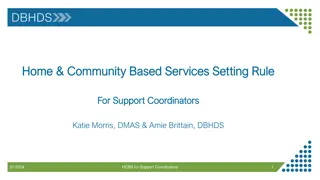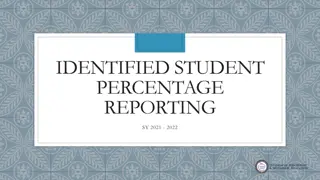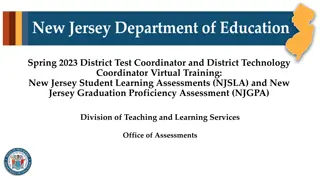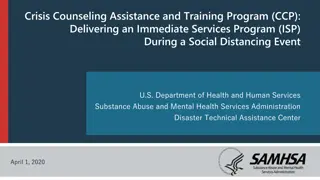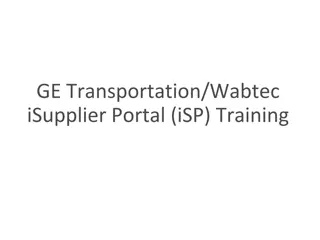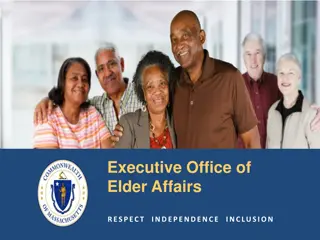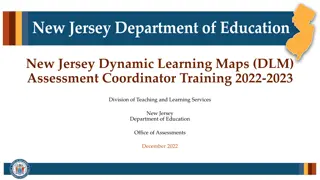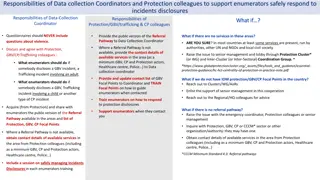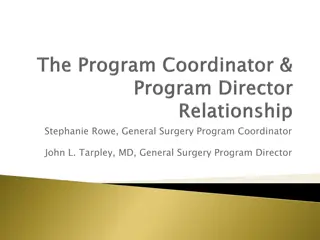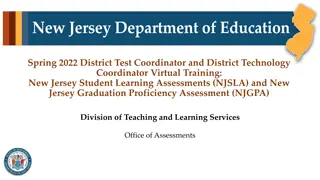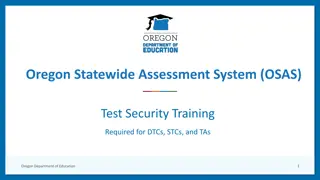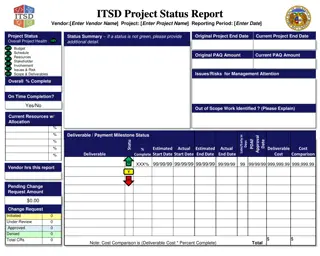Understanding Change in Status & ISP Training for Support Coordinators
This training focuses on ensuring Support Coordinators understand and apply the critical concepts of change in status and ISP implementation appropriately. Supervisors play a key role in supporting SCs in this process. By the end of the training, participants will be able to identify, assess, document, and respond to these factors effectively. The definitions of change in status and ISP implementation are crucial for the health and well-being of individuals supported. Face-to-face visits are essential for assessing individuals' status and service satisfaction.
Download Presentation

Please find below an Image/Link to download the presentation.
The content on the website is provided AS IS for your information and personal use only. It may not be sold, licensed, or shared on other websites without obtaining consent from the author. Download presentation by click this link. If you encounter any issues during the download, it is possible that the publisher has removed the file from their server.
E N D
Presentation Transcript
Support Coordination/Case Management Training Understanding and assessing Change in Status and ISP Implemented Appropriately
Primary Reasons People have needed supports Services are responsive and effective People are healthy, safe, and connected 2
The Role of the Supervisor This training is part of a phased approach to ensuring that two critical phrases are understood and applied consistently by Support Coordinators - change in status and ISP implemented appropriately. Supervisors are key in supporting SCs to understand this process and apply the concepts described. Look- behind Train Assess 3
Objectives By the end of this training, you will be able to identify: the definition of change in status the definition of ISP implemented appropriately how to assess for these two factors during face to face visits how to document and report findings how respond when concerns occur 4
About the Definitions The two phrases change in status and ISP implemented appropriately are critical to ensuring the health and wellness of people supported must be understood and applied consistently across Support Coordinators/Case Managers require careful consideration with each encounter with a person who has services and supports under Virginia s DD waivers and through discussions with people supporting the person 5
Relationship to Requirements "Face-to-face visit" in the person s service setting (e.g. residential, employment, or day) means an in-person meeting between the support coordinator and the individual and family/caregiver, as appropriate, for the purpose of assessing the individual's status and determining satisfaction with services, including the need for additional services and supports. 12VAC30-122-20 6
Relationship to Requirements At face-to-face meetings, the case manager shall (i) observe and assess for any previously unidentified risks, injuries, needs, or other changes in status; (ii) assess the status of previously identified risks, injuries, or needs, or other changes in status; (iii) assess whether the individual's service plan is being implemented appropriately and remains appropriate for the individual; and (iv) assess whether supports and services are being implemented consistent with the individual's strengths and preferences and in the most integrated setting appropriate to the individual's needs. 12VAC35-105-1245 7
Relationship to Requirements The local department of social services adult protective services unit or child protective services unit, as appropriate, and the DBHDS Offices of Licensing and Human Rights and DMAS shall be notified immediately of the emergency discontinuation of services by the support coordinator and the provider when the individual's health, safety, or welfare may be in danger. 12VAC30-122-100 8
Support Coordinator Role includes Advocating for individuals in response to their changing needs; Planning for transitions in the individual's life; Knowing and monitoring the individual's health status, any medical conditions, and his medications and potential side effects, and assisting the individual in accessing primary care and other medical services, as needed; and Understanding the capabilities of services to meet the individual's identified needs and preferences 12VAC35-105-1240 9
Support Coordinator Role includes Communicating with providers to share vital information Communicating with Care Coordinators of the Managed Care Organizations (MCOs) to update them on an individual's needs and services and obtain results of their HRAs Collaborating with care coordinators regarding medically related issues to develop coordinated plans to mitigate risks and risks of harm Reporting alleged abuse, neglect or exploitation to Adult Protective Services (APS) and Child Protective Services https://sccmtraining.partnership.vcu.edu/chapter10/chapter10.html 10
Change in Status Has the person s standing changed? 11
Change in Status (definition) Change in status refers to changes related to a person s mental, physical, or behavioral condition and/or changes in one s circumstances to include representation, financial status, living arrangements, service providers, eligibility for services, services received, and type of services or waiver. 12
Change in Status A person s status can change for various reasons. For example: It has been six months since the annual meeting and the person is not yet receiving a needed service has been removed from a service that was not replaced has declined a service that was needed is not making progress toward his outcomes 13
Action Cycle NOTE: Issues related to abuse, neglect, or exploitation or other health and safety concerns must be reported immediately to APS/CPS and DBHDS* as appropriate Report concerns as needed to your supervisor and appropriate state agency (APS/CPS), and DBHDS Human Rights and/or Licensing Explore the issues and make efforts to resolve concerns Document the resolution of the issue Implement plans to resolve issue *DBHDS determines departmental response and follows up as needed Document issue in the record Convene and mobilize the team > 2 weeks unresolved (unless urgent and needing immediate reporting) 14
Important Contacts Virginia Department of Social Services 24-hour, toll-free Adult Protective Services (APS) hotline at (888) 832-3858 Virginia Department of Social Services 24-hour, toll-free Child Protective Services (CPS) Hotline at (800) 552-7096 DBHDS Office of Human Rights http://www.dbhds.virginia.gov/assets/doc/QMD/human-rights/human-rights-contacts.pdf DBHDS Office of Licensing http://www.dbhds.virginia.gov/assets/doc/QMD/OL/ol-complaint- form_nov_18_19_distributed.pdf 15
Meeting Options Convening a team meeting when unable to resolve concerns Efforts should be made to explore and resolve issues, where possible, before considering a meeting. When needed, meetings include the person, Substitute- Decision Maker, if applicable, Support Coordinator/Case Manager, relevant providers needed for their combined expertise and involvement, and others desired by the person. They can be in person, by conference call, and/or Support Coordinator/Case Manager by phone to all parties. 16
ISP Implemented Appropriately ISP implemented appropriately means that services identified in the ISP are delivered consistent within generally accepted practices and have demonstrated progress toward expected outcomes, and if not, have been reviewed and modified. Consider all of the following: the assessment, the written plan, targets, data collection, reviews, and changes as needed 17
ISP Implemented Appropriately Generally accepted practice includes: ISPs that: include activities that are allowable include skill-building as required address preferences and health-related needs are overseen by qualified supervisors Services that: are provided in accordance with the plan (which includes the assessment, the written plan, targets, data collection, reviews, and changes as needed) are provided by qualified providers And documentation that: matches desired outcomes and describes progress 18
ISP Implemented Appropriately A note about providers SCs are not responsible for checking individual staff qualifications, but should be able to identify that those providing support understand the needs and preferences of the person. Part of the role of a Support Coordinator/Case Manager is to monitor services and support - be sure to ask, observe, and learn. Are DSPs providing person-centered supports consistent with the ISP and behavior support plan, as applicable? Do the DSPs know the person and their role in providing these services? 19
ISP Implemented Appropriately (definition) Generally accepted practice includes: The Support Coordinator s assessment of whether a service is being implemented, that is, consistent with generally accepted practices and if there are no records of expected progress or no progress is evident after six months of implementation then further review is required. Any progress or lack of progress should be included in an explanatory note in the person s record. 20
On-Site Visit Tool This training introduces a tool to support on-site visits and to help assure both change in status and ISP implemented appropriately are applied more consistently. 21
On-Site Visit Tool Complete once monthly when visits occur, but no less than once per quarter ECM = 1 time per month TCM = at least once per month if you see the person during the month, no less than once per quarter 22
On-Site Visit Tool Upload the checklist to WaMS under attachments in the Person s Information section outside of the ISP (select On-Site Visit Tool drop down) 23
On-Site Visit Tool Captures information: Name, location, date of visit, service provided Focus areas and actions needed related to: Change in Status and ISP Implemented Appropriately Space to document who will be notified and any plan changes, if needed 24
On-Site Visit Tool The OSVT has examples that can be viewed by hovering over links or using control+click to navigate to instructions and a crosswalk at the bottom of the format. 25
On-Site Visit Tool Questions guide assessment 26
On-Site Visit Tool Details and actions are described in the contact note in the EHR 27
On-Site Visit Tool About signatures Only one signature is needed Only the Support Coordinator s signature is needed on the OSVT The Support Coordinator lists who will be notified, which serves as an affirmation that reporting will occur Details must be included in the contact note 28
On-Site Visit Tool DBHDS will collect results from the On-Site Visit Tool and a sample of SC notes to: Assure that Support Coordination services adequately meet the Settlement Agreement provision V.F.2 in a consistent manner Confirm that assessments occur in relation to change in status and ISP implemented appropriately Assure reporting is occurring where concerns are noted Formulate systemic responses to address areas of concern 29
How to assess Work Home Community 30
How to Assess Assessing for change in status and ISP implemented appropriately includes observing and asking questions through which Support Coordinators can assess for changes and monitor the services provided. The following questions are designed to guide the assessment. On-Site Visit Tool Examples 31
How to Assess: Change in Status 1. Are there new or increased concerns with the environment being clean, safe and appropriate to the person s needs? (e.g., new or worsening evidence of infestation or unpleasant odor, observable concerns such as torn carpets, unsafe throw rugs, a lack of toilet paper, food, soap or other needed supplies, and the setting is physically is accessible with no barriers noted, etc.) 2. Are environmental modifications or assistive technologies lacking, but needed to increase independence or prevent institutionalization? (e.g., there is an appropriate integration of setting and supports available to promote the individual s independence and/or access to the greater community, wheelchair, walker, communication device, etc.) 32
How to Assess: Change in Status 3. Are there new or increased concerns with the person s healthy and safety? (e.g., is there a new diagnosis from the past 90 days that could increase risk, such as going to the emergency room for an accident, injuring oneself and without effective behavioral services, signs of inadequate care like skin breakdown or choking that could have been avoided, or other changes in physical appearance: hygiene, weight, physical marks, etc.) 4. Have there been any significant life changes that impact services? (e.g., the loss of a day, residential, or behavioral service provider, change in financial status, benefits, eligibility for services, or a change in waiver status, etc.) 5. Are there any concerns related to potential abuse, neglect, or exploitation? (e.g., apparent bruising, unexplained scratches or pain, evidence of significant untreated health issues such as dental pain, body odor, soiled clothing, missing funds are reported, etc.) 33
How to Assess: Change in Status 6. Was a change in status identified? This question is the determination of change in status. An answer of yes to any question 1 to 5 indicates a change in status. If necessary, the last section will capture who will be informed of the change and the parts of the plan that will be updated. Details will be recorded in the contact note from this visit. 34
How to Assess: Services Implemented Appropriately 7. Does the person express satisfaction with services and the progress being made? (e.g., pleased with all services, locating new services in a timely manner, developing increased abilities, opportunities for inclusion, having more independence, etc.) 8. Are the paid supporters knowledgeable about the person and understand their role in providing support? (e.g., do the DSPs know the individual s needs and understand their role in providing support? Are meal plans followed to include special equipment, preparation, and preferences?) 9. Are behavioral services available and occurring as needed, and as authorized? (i.e., number of days and hours authorized) 35
How to Assess: Services Implemented Appropriately 9a. If no to question 9 for behavioral services, confirm the following: An onsite assessment was completed? A behavioral plan designed to decrease negative behavioral and increase functional replacement behaviors? Caregivers are trained to implement the behavior plan? Presence of data collection/reviews to improve supports? Changes were made to the behavioral plan as needed? Question 9a is only answered if the answer to question 9 is no. Consider each question. Discuss with the provider and review documentation as needed to determine the answers to these questions. If any answer is no, determine the actions needed such as communicating with the provider, seeking additional documentation, or offering alternate options to the person/Substitute Decision-Maker. 36
How to Assess: Services Implemented Appropriately 10. Are nursing services available and occurring as needed, and as authorized? (i.e., number of days and hours authorized) 10a. If no to question 10 for nursing services, confirm the following: Services were provided consistently for past 90 days? The hours provided are sufficient to ensure health and safety? The services provided meet the person s identified needs? Question 10a is only answered if the answer to question 10 is no. Consider each question. Discuss with the provider and review documentation as needed to determine the answers to these questions. If any answer is no, determine the actions needed such as communicating with the provider, seeking additional documentation, or offering alternate options to the person/Substitute Decision-Maker. 37
How to Assess: Services Implemented Appropriately 11. Has the service being provided during this visit been occurring as needed, and as authorized? (i.e., number of days and hours authorized); N/A only utilized if not receiving a service at the time of the visit. 12. Does the service being provided during this visit include skill-building if required? (e.g., progress is occurring as expected, data is collected and reviewed by the provider; this is a required element in certain services to focus on increasing independence based on the ISP) 13. Does community involvement occur as described in the ISP? (e.g., person has natural supports, do individual activity schedules and reports confirm going out to places they choose and like as indicated in the ISP, has access to reliable transportation, any modifications are supported as documented in the plan) 38
How to Assess: Services Implemented Appropriately 14. Are services implemented appropriately? This question is the determination of services implemented appropriately. An answer of no to any question 7 to 13 indicates that services are not implemented appropriately. If necessary, the last section will capture who will be informed of the change and the parts of the plan that will be updated. Details will be recorded in the contact note from this visit. 39
Determine Actions Needed A variety of actions might be needed to address concerns. This could include reporting emergencies and concerns appropriately, bringing the team together, and offering alternate options. Use the reference chart provided with the tool as you consider possible actions. Possible actions include: Call 911 if health and safety is at immediate risk; Discuss with the provider; Notify the Department of Social services Adult or Child Protective Services Hotline to file a report; Submit a report to the DBHDS Office of Human Rights and if there is an injury or the allegation involves sexual abuse, Submit a report to the DBHDS Office of Licensing Report to the Substitute Decision-Maker or provider(s) as appropriate Report to your supervisor per agency policies; Document the issue; Convene a team meeting if necessary; Ensure any concerns have been addressed and resolved; Confirm corrective actions have been taken to reduce chances of reoccurrence and offer alternate service options; Make referrals if needed; Update the ISP as needed 40
Reporting and Plan Updates 15. Do any concerns observed or reported require reporting to the family or any providers? Some observations/reports require informing the family or one or more waiver providers. For this question, list who will be contacted and describe what will be shared in the contact note from this visit. 16. Do any concerns observed or reported require reporting to DBHDS or other state agency or your supervisor? Some observations/reports require reporting to the Department of Social Services, DBHDS, DMAS, or your supervisor. For this question, list who will be contacted and describe what will be shared in the contact note from this visit. 17. Is a change in the plan needed (additional outcomes, changes in steps or provider instructions)? If results of the completion of this tool indicate that a change in the person s ISP Parts I to IV or the provider- completed Part V, list the parts of the plan that will be updated. Describe the changes that will be discussed with the person and Substitute Decision-Maker and made to the plan in the contact note from this visit. 41
Completing the note Notes should include: Full date of contact Name and titles of person contacted Place of contact Type of contact Summary of contact to include findings with changes in status and service implementation Follow-up to include who will be contacted and what will be shared How plans will change if needed Satisfaction with services Signature/electronic signature and date 42
Resources OSVT and related materials available online at: http://www.dbhds.virginia.gov/ 43
Resources 44
Resources DBHDS Licensing Regulations https://law.lis.virginia.gov/admincode/title12/agency35/chapter105/ DMAS Proposed DD Waiver Regulations http://register.dls.virginia.gov/details.aspx?id=7347 SC/CM Training Modules and DD SC Manual through DBHDS http://www.dbhds.virginia.gov/case-management 45



